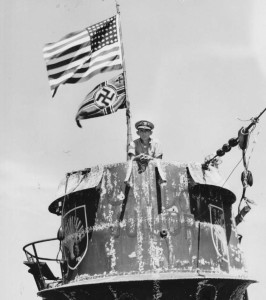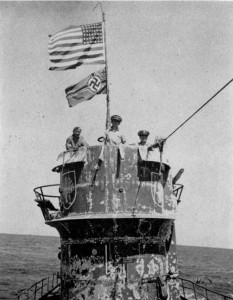Sandy and I recently shared cocktail hour with some good friends of ours. Joe grew up in upper New York in a town (Malone) twelve miles from the Canadian border and 58 miles south of Montreal. After World War II had ended, Joe’s father told him about the German U-boat activity in the St. Lawrence River and the effect it had on the Canadians.

According to Joe’s father, the French Canadians weren’t too worried about the German occupation of France and the collaborationist government known as Vichy. That is until a U-boat was discovered in Montreal Harbor and stories of German spies being off loaded onto Canadian soil. That woke them up.
The Battle of the St. Lawrence
This is the term used today to describe the periods of time when the U-boats actively hunted down convoy boats in the St. Lawrence River. There were two primary periods of activity: May 1942 to September 1943 and then a resumption of activity in the fall of 1944 (due to a new technology on the submarines that allowed them to stay submerged longer).
The two primary ports used for troop and material transport to Europe were Halifax and Sydney, Nova Scotia. The Germans routinely would patrol those waters looking for their victims. The submarines stepped up their activity along the east coast of the river between early 1942 to late 1943. While it did cause the sinking of some ships and loss of life, the U-boat activity was primarily psychological and destructive to the Canadian psyche.
While the Canadian government was woefully unprepared to meet the challenges of defending against the submarines, Hitler never really took full advantage of his opportunities. He sent relatively few submarines into the St. Lawrence River, preferring to concentrate his wolf packs in the Atlantic. The Kriegsmarine (German naval high command) could never get Hitler to fully understand sea warfare.
As the war progressed, the Royal Canadian Navy got better at defending against the U-boats. Additional equipment became available and their efforts began to payoff with the sinking of many submarines. By late 1943, the river’s shipping lanes were reopened to domestic traffic—the Germans had decreased their U-boat activities by that time.
Infiltration of the Great Lakes
One of the mysteries was how far down the St. Lawrence River did the U-boats get? Because of the news blackouts, there was a tremendous amount of misinformation provided primarily by gossip. You had stories of U-boat sailors disembarking for an evening of fun in various Canadian towns along the river. Stories abounded with the tales of daylight U-boat activities. Perhaps all of this was a collective hallucination caused by fear. Most likely it was due to a void of the reporting of factual news.
Part of the gossip involved sightings of U-boats in areas that were never confirmed. One of these was the distance they traveled down the river. While most of the activity took place further north at the mouth of the river, it was commonly known the submarines made their way down the river as far as Montreal. But did they go any further—like into the Great Lakes?
There was a recent article about recreational scuba divers finding what they thought was the wreckage of a U-boat sitting on the bottom of Lake Ontario. The article stated that U.S. Coast Guard deep-sea divers and archaeologists from Niagara University were alerted and quickly confirmed it was a U-boat and began a recovery/salvage operation.
Unfortunately, the article is fake. Legends (and hallucinations) abound concerning the German U-boats and their activities during the war, including the number sunk. The question of how far south any of the U-boats went remains unanswered.
The U-505

So at this point, the only U-boat I know that made it to the Great Lakes was the captured U-505. It was hauled through the Great Lakes in 1954 to its eventual resting place in Chicago at the Museum of Science and Industry. It is the only U-boat on exhibit in North America. The story of the men who captured it before the Germans could scuttle the boat is very impressive. Make it a priority stop the next time you visit Chicago.
We need your help
Please tell your friends about our blog site and encourage them to visit and subscribe. Sandy and I are trying to increase our audience and we need your help through your friends and social media followers.
Thank You
Sandy and I appreciate you visiting with us. We have some exciting things on the horizon and we’ll keep you updated as we go along.
What’s New With Sandy and Stew?
Stew is working on creating the walks and individual stops for the next books: Where Did They Put the Gestapo Headquarters?—A Walking Tour of Nazi Occupied Paris (1940–1944). It’s clear that almost every building in Paris has a story associated with the Occupation years. It is a matter of identifying them and then prioritizing the stops for you. This is quite a process considering the tangents and rabbit holes I end up going down. But it is a lot of fun if not quite depressing at times.
We have a lot of stories and we’re looking forward to sharing these with you. Please continue to visit our blog site and perhaps you’d like to subscribe so that you don’t miss out on our blog posts, past and current.
Share This:
Follow Stew:
Find Stew’s books on Amazon and iBooks.
Please note that we do not and will not take compensation from individuals or companies mentioned or promoted in the blogs.
Walks Through History
Copyright © 2016 Stew Ross
